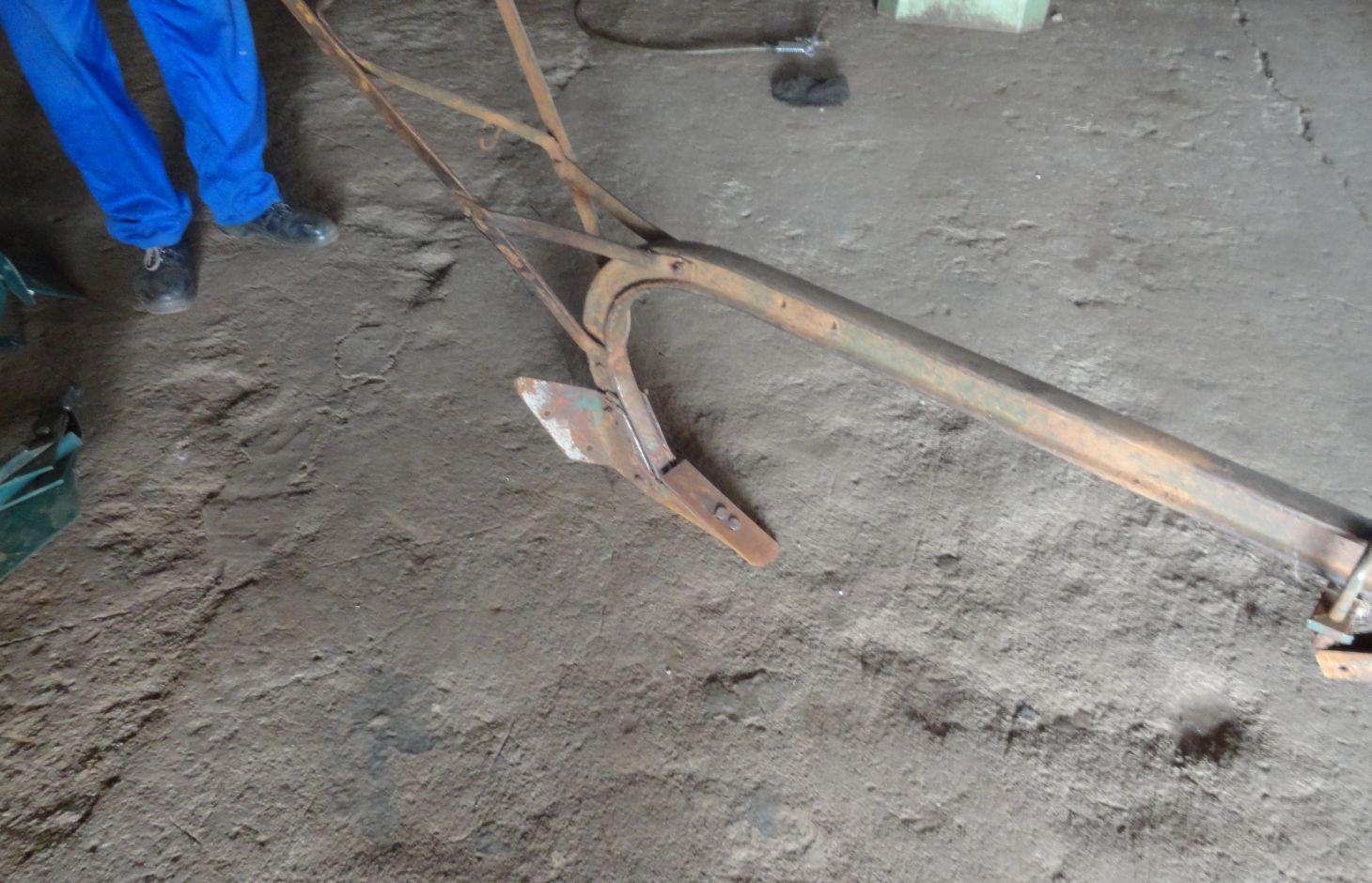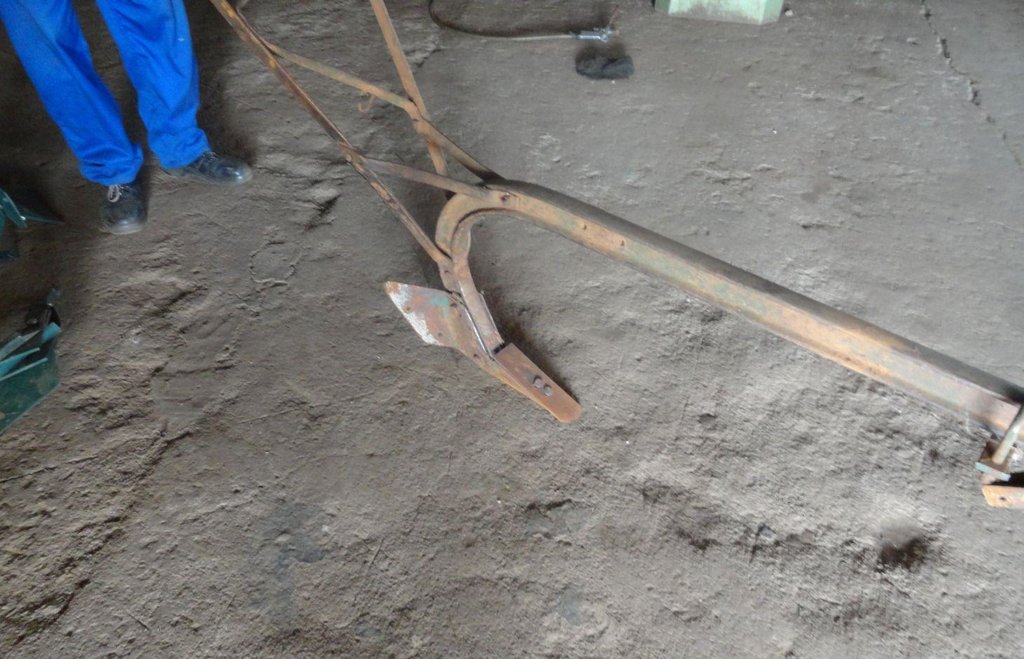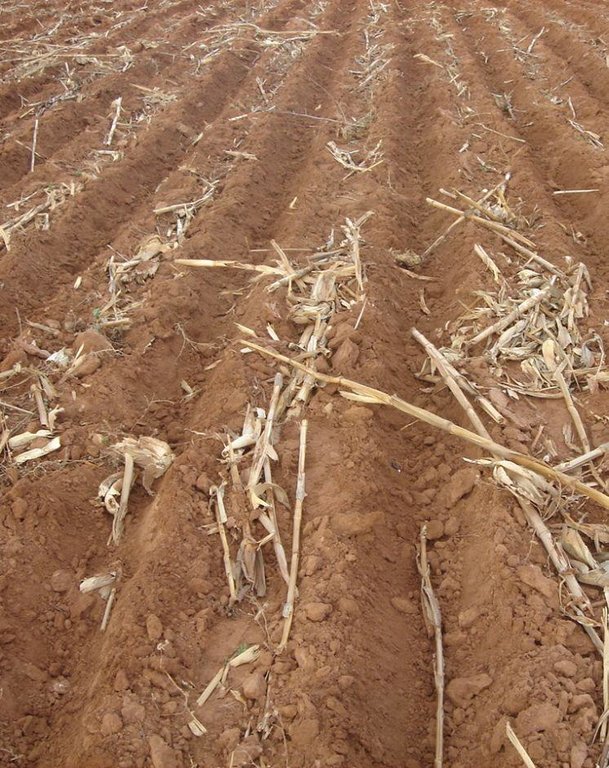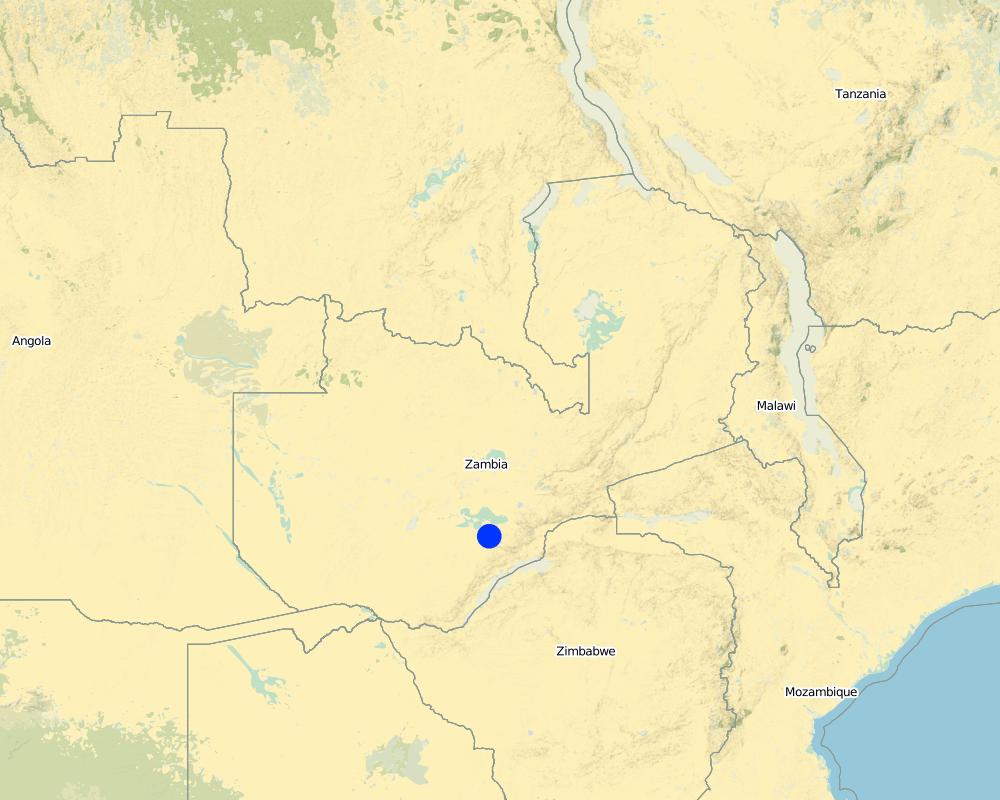Conservation Tillage with Magoye Ripper [Zambia]
- Creación:
- Actualización:
- Compilador: Silenga Wamunyima
- Editor: –
- Revisor: Fabian Ottiger
Minimum tillage
technologies_1139 - Zambia
Visualizar secciones
Expandir todo Colapsar todos1. Información general
1.2 Detalles de contacto de las personas de referencia e instituciones involucradas en la evaluación y la documentación de la Tecnología
Especialista MST:
Especialista MST:
Katoweji Alfred
(+260) 211 213 739
Golden Valley Agricultural Research Trust
PO. Box 50834 Lusaka
Zambia
Especialista MST:
Ndandula Sharon
(+260) 211 213 739
Golden Valley Agricultural Research Trust
PO. Box 50834 Lusaka
Zambia
Nombre de la(s) institución(es) que facilitaron la documentación/ evaluación de la Tecnología (si fuera relevante)
Golden Valley agricultural research trust (Golden Valley agricultural research trust) - Zambia1.3 Condiciones referidas al uso de datos documentados mediante WOCAT
¿Cuándo se compilaron los datos (en el campo)?
15/01/2013
El compilador y la/s persona(s) de referencia claves aceptan las condiciones acerca del uso de los datos documentados mediante WOCAT:
Sí
1.5 Referencia al (los) Cuestionario(s) de Enfoques MST
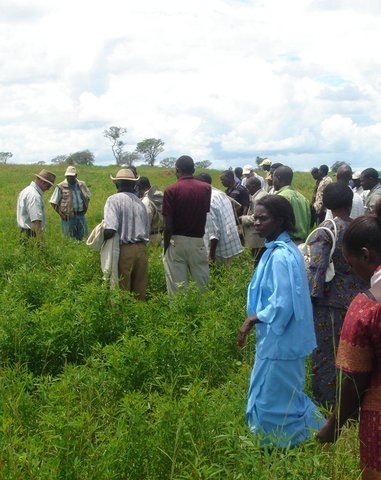
Participatory Research and Development [Zambia]
This is a collaborative process between researchers and farmers for developing and adapting new technologies that focus on incorporating the perspectives and inputs from the farmers into the development process.
- Compilador: Arthur Chomba
2. Descripción de la Tecnología MST
2.1 Breve descripción de la Tecnología
Definición de la Tecnología:
Conservation Tillage with the Magoye Ripper is an animal draft reduced tillage method that involves the use of the Magoye Ripper to loosen the soil by shattering with a tine instead of ploughing.
2.2 Descripción detallada de la Tecnología
Descripción:
The Magoye Ripper is an animal drawn implement used for conservation tillage. The Ripper consists of a frame that is attached to a common plough beam and on this frame is fixed a tine at an angle that penetrates and breaks up the soil when pulled. Only the region where the crop furrow will be is loosened by the tine and by so doing reducing the amount of tillage and disruption of soil structure while preserving the crop residue cover. The frame has some ‘wings’ attached to it that throw the soil out of the ripped furrow to leave it open for planting and collecting of water. Ripping is done in one pass up to a depth of 15cm depending on the strength of the oxen, soil type, hitch assembly settings and the sharpness of the tine.
Purpose of the Technology: Reducing tillage first of all reduces tillage costs and tillage time allowing more time for the farmer to plant early and/or a bigger area. Reducing tillage also reduces the loss of soil organic matter and the destructive effects to the soil structure ultimately improving soil fertility and soil water conservation. Ripping does not invert the soil, hence it does not bury crop residues which further enhance organic matter levels and protect the soil from excessive evaporation and erosion. The open furrow left by the ripper collects water from the adjacent untilled soil much in the same way basins (zai system) are used for water harvesting. This together with the increased rooting depth resulting from the breaking of compacted soil, enhanced infiltration and early planting improves water conservation and hence the resilience of crop to extended dry spells.
Establishment / maintenance activities and inputs: The establishment of ripping based conservation tillage mainly involves the purchase of the ripper frame and the
replaceable tines. Liming acidic soils (low pH soils) followed by a final ploughing will be required to correct the soil pH which otherwise will be difficult to correct once conservation tillage has been established. The main establishment activity involves adopting a new mindset and increasing the knowledge base to apply the technology correctly. Knowledge about alternative weed control practices and herbicide use is particularly cardinal as the farmer will have to adopt new weeding practices and routines in the absence of ploughing. Maintenance activities are more or less the same as conventional tillage except for replacing the tillage tines which wear every now and then. The same applies for the inputs except for the increase in use of herbicides.
Natural / human environment: Ripping is best performed in dry season when the soil is dry although this may not be possible with some of the smaller and/or weak oxen when the soil is too dry. It is therefore recommended for farmers in regions that experience long dry seasons to rip at the end of harvest before the soils get too dry and hard and when the oxen are in good condition before they lose weight and strength due to less feed and water, excessive heat as the dry season progresses.
The ripper is mostly suited to small-scale farmers just adopting Conservation Agriculture (CA) since the tool can be easily adapted to the existing plough beam which most of the farmers already have. The small capital outlay for establishing the system makes it suited to resource poor and risk-averse farmers.
2.3 Fotografías de la Tecnología
2.5 País/ región/ lugares donde la Tecnología fue aplicada y que se hallan comprendidos por esta evaluación
País:
Zambia
Región/ Estado/ Provincia:
Zambia/Southern Province
Especifique más el lugar :
Mazabuka/Magoye
Map
×2.6 Fecha de la implementación
Si no se conoce el año preciso, indique la fecha aproximada:
- 10-50 años atrás
2.7 Introducción de la Tecnología
Especifique cómo se introdujo la Tecnología:
- durante experimentos/ investigación
Comentarios (tipo de proyecto, etc.):
The Magoye Ripper was introduced in 1995 after a period of adaptive research by government research branch under a project supported by the Netherlands government.
3. Clasificación de la Tecnología MST
3.1 Propósito(s) principal(es) de la Tecnología MST
- reducir, prevenir, restaurar la degradación del suelo
3.2 Tipo(s) actuales de uso de la tierra donde se aplica la Tecnología

Tierras cultivadas
- Cosecha anual
Cosechas principales (comerciales y de subsistencia):
Major cash crop: Cotton, maize
Major food crop: Maize
Major other crops: Groundnuts

Cultivos asociados (cultivos/ pastoreo/ árboles), incl. agroforestería
- Agropastoreo
Principales productos/ servicios:
Main species seminomadism/pastoralism: Cattle, goats, pigs
Comentarios:
Major land use problems (compiler’s opinion): Loss of soil structure and loss of soil fertility
Major land use problems (land users’ perception): Droughts and dry dpells
Livestock is grazing on crop residues
3.3 Información adicional sobre el uso de tierras
Provisión de agua para la tierra donde se aplica la Tecnología:
- de secano
Número de temporadas de cultivo por año:
- 1
Especifique:
Longest growing period in days: 135 Longest growing period from month to month: Mid November to end of March
Densidad del ganado (si fuese relevante):
1-10 LU /km2
3.4 Grupo MST al que pertenece la Tecnología
- perturbación mínima del suelo
3.5 Difusión de la Tecnología
Especifique la difusión de la Tecnología:
- distribuida parejamente sobre un área
Si la tecnología se halla difundida homogéneamente en un área, indique el área aproximada que cubre:
- 0.1-1 km2
Comentarios:
250 rippers were distributed in Magoye and surveys show that only about half of these farmers continued to use the ripper. The field sizes range from 1/4ha to 1/2ha.
3.6 Medidas MST que componen la Tecnología

medidas agronómicas
- A2: materia orgánica/ fertilidad del suelo
- A6: Otros
Comentarios:
Main measures: agronomic measures
Specification of other agronomic measures: Reduced Tillage, Crop Residues
Type of agronomic measures: early planting, mulching, manure / compost / residues, mineral (inorganic) fertilizers, soil conditioners (lime, gypsum), rotations / fallows, breaking compacted topsoil, minimum tillage, non-inversion tillage, furrows (drainage, irrigation), breaking compacted subsoil
3.7 Principales tipos de degradación del suelo encarados con la Tecnología

erosión de suelos por agua
- Wt: pérdida de capa arable/ erosión de la superficie

deterioro químico del suelo
- Cn: reducción de la fertilidad y contenido reducido de la materia orgánica del suelo (no ocasionados por la erosión)

deterioro físico del suelo
- Pc: compactación

degradación biológica
- Bl: pérdida de la vida del suelo
Comentarios:
Main type of degradation addressed: Cn: fertility decline and reduced organic matter content, Pc: compaction, Bl: loss of soil life
Secondary types of degradation addressed: Wt: loss of topsoil / surface erosion
Main causes of degradation: soil management (Over-ploughing), crop management (annual, perennial, tree/shrub) (Monocropping), overgrazing (Crop residues overgrazed leaving land exposed), poverty / wealth (under application of fertilizer leading to nutrient mining, charcoal burning)
Secondary causes of degradation: deforestation / removal of natural vegetation (incl. forest fires) (Charcoal burning), Heavy / extreme rainfall (intensity/amounts) (high intensity storms leading to erosion), droughts (resulting in inadequate soil cover), land tenure (communal land over-exploited), governance / institutional (lack of credit facilities)
3.8 Prevención, reducción o restauración de la degradación del suelo
Especifique la meta de la Tecnología con relación a la degradación de la tierra:
- reducir la degradación del suelo
Comentarios:
Secondary goals: prevention of land degradation, rehabilitation / reclamation of denuded land
4. Especificaciones técnicas, actividades de implementación, insumos y costos
4.1 Dibujo técnico de la Tecnología
Autor:
Silenga Wamunyima, Box 670577, Mazabuka, Zambia
4.2 Especificaciones técnicas/ explicaciones del dibujo técnico
Planting rip lines are done at a depth of 15-20 cm with inter row of 75 or 90 cm, 30-40 cm depth of the furrow of ripping can be achieved. This is achieved by running the ripper through the same rip line twice so that the tine gets deeper into the soil. The width of the open furrow is 10-15 cm wide. Ripping is done across the slope to reduce runoff. Ripping is best performed and recommended done in the dry season.
Location: Magoye. Mazabuka/Southern Province/Zambia
Date: 2014-06-29
Technical knowledge required for field staff / advisors: high (The use of the Ripper itself is simple but applying it as part of a conservation agriculture system can be knowledge demanding.)
Technical knowledge required for land users: moderate (adapting the production system to accommodate the Ripper will require learning new practices for weeding, planting and fertility management.)
Main technical functions: improvement of ground cover, improvement of topsoil structure (compaction), improvement of subsoil structure (hardpan), increase of infiltration, water harvesting / increase water supply
Secondary technical functions: control of raindrop splash, improvement of surface structure (crusting, sealing), increase in organic matter, increase in nutrient availability (supply, recycling,…), increase / maintain water stored in soil, increase of groundwater level / recharge of groundwater
Early planting
Material/ species: maize, cotton
Quantity/ density: 44,000 pla
Remarks: 25cm intra row by 75cm
Mulching
Material/ species: crop residues
Quantity/ density: 3ton/ha
Remarks: uniformly spread
Manure / compost / residues
Material/ species: residues
Quantity/ density: 3ton/ha
Remarks: uniformly spread
Mineral (inorganic) fertilizers
Material/ species: Basal and top dressing
Quantity/ density: 400kg/ha
Remarks: spot application
Soil conditioners (lime, gypsum)
Material/ species: lime
Quantity/ density: 1ton/ha
Rotations / fallows
Material/ species: maize in rotation with cotton, groundnuts and cowpeas
Breaking compacted topsoil
Material/ species: Ripping with Magoye Ripper at 15cm depth
Remarks: 75cm or 90cm row spacing
Minimum tillage
Material/ species: ripping
Non-inversion tillage
Material/ species: ripping
Furrows (drainage, irrigation)
Material/ species: ripped lines leave furrows for water harvesting
Breaking compacted subsoil
Material/ species: deep ripping at 20cm
4.3 Información general sobre el cálculo de insumos y costos
otra / moneda nacional (especifique):
Kwacha
Indique la tasa de cambio de USD a la moneda local (si fuese relevante): 1 USD =:
5,0
Indique el costo promedio del salario de trabajo contratado por día:
2.40
4.4 Actividades de establecimiento
| Actividad | Tipo de medida | Momento | |
|---|---|---|---|
| 1. | Purchase magoye ripper | Agronómicas | |
| 2. | Purchase knapsack sprayer | Agronómicas |
Comentarios:
Lifespan of the magoye ripper: 7 years
Lifespan of the Knapsack sprayer: 5 years
4.5 Costos e insumos necesarios para el establecimiento
| Especifique insumo | Unidad | Cantidad | Costos por unidad | Costos totales por insumo | % de los costos cubiertos por los usuarios de las tierras | |
|---|---|---|---|---|---|---|
| Equipo | Magoye ripper | Tool | 1,0 | 50,0 | 50,0 | 100,0 |
| Equipo | Knapsack sprayer | Tool | 1,0 | 80,0 | 80,0 | 100,0 |
| Costos totales para establecer la Tecnología | 130,0 | |||||
Comentarios:
Duration of establishment phase: 5 month(s)
4.6 Actividades de establecimiento/ recurrentes
| Actividad | Tipo de medida | Momento/ frequencia | |
|---|---|---|---|
| 1. | slashing and spreading residues | Agronómicas | May-June yearly after harvest |
| 2. | Ripping | Agronómicas | May-June after harvest |
| 3. | Liming | Agronómicas | Nov-Dec before planting |
| 4. | Planting and fertilizing | Agronómicas | Nov-Dec at onset of rains |
| 5. | chemical weeding | Agronómicas | 3 times |
| 6. | harvesting | Agronómicas | April-May |
4.7 Costos e insumos necesarios para actividades de mantenimiento/ recurrentes (por año)
| Especifique insumo | Unidad | Cantidad | Costos por unidad | Costos totales por insumo | % de los costos cubiertos por los usuarios de las tierras | |
|---|---|---|---|---|---|---|
| Mano de obra | Slashing and spreading residues | ha | 1,0 | 20,0 | 20,0 | 100,0 |
| Mano de obra | Ripping | ha | 1,0 | 50,0 | 50,0 | 100,0 |
| Mano de obra | Liming | ha | 1,0 | 42,0 | 42,0 | 100,0 |
| Mano de obra | Planting and fertilizing | ha | 1,0 | 40,0 | 40,0 | 100,0 |
| Material para plantas | Seeds | kg | 20,0 | 2,5 | 50,0 | 100,0 |
| Fertilizantes y biocidas | Fertilizer | kg | 400,0 | 0,8 | 320,0 | 100,0 |
| Otros | Herbicides | liters | 5,0 | 6,0 | 30,0 | 100,0 |
| Otros | Labour: Chemical weeding | ha | 1,0 | 24,0 | 24,0 | 100,0 |
| Otros | Labour: Harvesting | ha | 1,0 | 20,0 | 20,0 | 100,0 |
| Indique los costos totales para mantenecer la Tecnología | 596,0 | |||||
Comentarios:
Machinery/ tools: Magoye Ripper
Calculation are for a 1ha of maize under magoye ripper based conservation tillage and costs are for the Zambia situation in Magoye as of August 2012.
4.8 Factores más determinantes que afectan los costos:
Describa los factores más determinantes que afectan los costos:
The weed control method employed is the main determinate factor depending on whether the farmer uses hand hoe or herbicides. Abandoning ploughing leads to higher weed densities leading to increased labour requirements/recurrent costs if hand weeding is used. However, with herbicides the weeding labour demand and costs cost are much lower by a factor of about 5. Another major cost is that of fertilizer which makes up about half the cost hence the total cost will vary significantly depending on fertilizer cost.
5. Entorno natural y humano
5.1 Clima
Lluvia anual
- < 250 mm
- 251-500 mm
- 501-750 mm
- 751-1,000 mm
- 1,001-1,500 mm
- 1,501-2,000 mm
- 2,001-3,000 mm
- 3,001-4,000 mm
- > 4,000 mm
Especificaciones/ comentarios sobre la cantidad de lluvia:
Average rainfall 700mm, summer rains from November to March.
Zona agroclimática
- semi-árida
Thermal climate class: subtropics. 3 distinct seasons – summer, winter and one rainy season
5.2 Topografía
Pendientes en promedio:
- plana (0-2 %)
- ligera (3-5%)
- moderada (6-10%)
- ondulada (11-15%)
- accidentada (16-30%)
- empinada (31-60%)
- muy empinada (>60%)
Formaciones telúricas:
- meseta/ planicies
- cordilleras
- laderas montañosas
- laderas de cerro
- pies de monte
- fondo del valle
Zona altitudinal:
- 0-100 m s.n.m.
- 101-500 m s.n.m.
- 501-1,000 m s.n.m
- 1,001-1,500 m s.n.m
- 1,501-2,000 m s.n.m
- 2,001-2,500 m s.n.m
- 2,501-3,000 m s.n.m
- 3,001-4,000 m s.n.m
- > 4,000 m s.n.m
Comentarios y especificaciones adicionales sobre topografía :
Slopes on average: Also flat and moderate (classed 2) and rolling (classed 3)
5.3 Suelos
Profundidad promedio del suelo:
- muy superficial (0-20 cm)
- superficial (21-50 cm)
- moderadamente profunda (51-80 cm)
- profunda (81-120 cm)
- muy profunda (>120 cm)
Textura del suelo (capa arable):
- mediana (limosa)
- fina/ pesada (arcilla)
Materia orgánica de capa arable:
- media (1-3%)
- baja (<1%)
Si se halla disponible, adjunte una descripción completa de los suelos o especifique la información disponible, por ej., tipo de suelo, pH/ acidez de suelo, capacidad de intercambio catiónico, nitrógeno, salinidad, etc. :
Soil fertility: Low (classed 1) and medium (classed 2, low fertility caused mainly by poor soil management practices, otherwise soil are inherently fertile)
Topsoil organic matter: Low (classed 1) and medium (classed 2, due to excessive ploughing and nutrient mining)
Soil drainage/infiltration: Good (classed 1, soils naturally are well drained except were soil have bee compacted by poor management practices) and medium (classed 2)
Soil water storage capacity: Medium (classed 1, soils mostly loam to sandy loam with medium storage capacity) and low (ranked 2)
5.4 Disponibilidad y calidad de agua
Agua subterránea:
> 50 m
Disponibilidad de aguas superficiales:
mediana
Calidad de agua (sin tratar):
agua potable de buena calidad
Comentarios y especificaciones adicionales sobre calidad y cantidad de agua:
Ground water table: <50m (ranked 1, hand wells are <20m but reliable boreholes are > 50m) and 5-50m (ranked 2)
Availability of surface water: Medium (mostly seasonal streams and dams)
Water quality (untreated): Good drinking water (ranked 1, from hand pumps (both communal and private)) and poor drinking water (treatment required, from hand dug wells, ranked 1 also)
5.5 Biodiversidad
Diversidad de especies:
- mediana
Comentarios y especificaciones adicionales sobre biodiversidad:
Human population densities are relatively low
5.6 Las características de los usuarios de la tierra que aplican la Tecnología
Ingresos no agrarios:
- 10-50% de todo el ingreso
Nivel relativo de riqueza:
- muy pobre
- pobre
Individuos o grupos:
- individual/ doméstico
Género:
- hombres
Indique otras características relevantes de los usuarios de las tierras:
Land users applying the Technology are mainly common / average land users
Difference in the involvement of women and men: The technology is applied mostly by men since most households are male headed and animal traction operation are reserved for men. Planting and weeding operations are the domain of women and children
Population density: 10-50 persons/km2
Annual population growth: 3% - 4%
8% of the land users are rich and own 15% of the land (own more than 10 cattle).
8% of the land users are average wealthy and own 15% of the land (own between 5 and 10 cattle).
16% of the land users are poor and own 20% of the land (own less than 5).
68% of the land users are poor and own 40% of the land (do not own cattle).
Off-farm income specification: sale of rainfed crops makes up about half of their income, the remainder coming from sale of livestock, petty trading, hiring out labour and remittances
Market orientation of production system: Mixed (subsistence/ commercial, sale of excess maize and cotton, dairy, ranked 1) and subsistence (self-supply, livestock, maize and legumes for home consumption, ranked 2),
Level of mechanization: Animal traction (ranked 1, families without cattle borrow or hire), mechanised (ranked 2) and manual labour (ranked 2, only for small backyard fields)
5.7 Área promedio de la tierra que pertenece a o es arrendada por usuarios de tierra que aplican la Tecnología
- < 0.5 ha
- 0.5-1 ha
- 1-2 ha
- 2-5 ha
- 5-15 ha
- 15-50 ha
- 50-100 ha
- 100-500 ha
- 500-1,000 ha
- 1,000-10,000 ha
- > 10,000 ha
¿Esto se considera de pequeña, mediana o gran escala (refiriéndose al contexto local)?
- pequeña escala
Comentarios:
Average area of land owned or leased by land users applying the Technology: Also: 5-15 ha, 15-50 ha, 50-100 ha
5.8 Tenencia de tierra, uso de tierra y derechos de uso de agua
Tenencia de tierra:
- individual, sin título
Derechos de uso de tierra:
- acceso abierto (no organizado)
- individual
- Land is apportioned by traditional leaders
Derechos de uso de agua:
- acceso abierto (no organizado)
- Land is apportioned by traditional leaders
5.9 Acceso a servicios e infraestructura
salud:
- pobre
- moderado
- bueno
educación:
- pobre
- moderado
- bueno
asistencia técnica:
- pobre
- moderado
- bueno
empleo (ej. fuera de la granja):
- pobre
- moderado
- bueno
mercados:
- pobre
- moderado
- bueno
energía:
- pobre
- moderado
- bueno
caminos y transporte:
- pobre
- moderado
- bueno
agua potable y saneamiento:
- pobre
- moderado
- bueno
servicios financieros:
- pobre
- moderado
- bueno
6. Impactos y comentarios para concluir
6.1 Impactos in situ demostrados por la Tecnología
Impactos socioeconómicos
Producción
producción de cultivo
Cantidad antes de MST:
1.8ton/ha
Cantidad luego de MST:
2ton/ha
Comentarios/ especifique:
mostly due to early planting
producción de forraje
Comentarios/ especifique:
crop residues needed for soil cover
riesgo de fracaso de producción
Comentarios/ especifique:
Better tolerance to dry spells
área de producción
Cantidad luego de MST:
20%
Ingreso y costos
gastos en insumos agrícolas
Comentarios/ especifique:
purchase of herbicides
ingreso agrario
Cantidad luego de MST:
15%
Comentarios/ especifique:
due to lower tillage cost, better yield
carga de trabajo
Comentarios/ especifique:
only if herbicicdes are used for weeding
Impactos socioculturales
seguridad alimentaria/ autosuficiencia
Comentarios/ especifique:
due to improved yields and more time and labour to diversify
oportunidades recreativas
Comentarios/ especifique:
Less time spent preparing land
mitigación de conflicto
Comentarios/ especifique:
competition for crop residues with neighbours cattle
Improved livelihoods and human well-being
Comentarios/ especifique:
Technology not yet been applied on a large enough area to make significant impact at community level but increased farm incomes among farmers has led to better education and health among household members.
Impactos ecológicos
Ciclo de agua/ escurrimiento de sedimento
calidad de agua
Comentarios/ especifique:
due to improved good drainage
cosecha/ recolección de agua
Comentarios/ especifique:
open furows collect water
escurrimiento superficial
Comentarios/ especifique:
due to better soil cover
drenaje de agua en exceso
Comentarios/ especifique:
due to improved soil structure
nivel freático/ acuífero
Comentarios/ especifique:
not applied extensively
evaporación
Comentarios/ especifique:
due to better soil cover
Suelo
humedad del suelo
Comentarios/ especifique:
due to resulting improved soil srtucture
cubierta del suelo
Comentarios/ especifique:
Due to non-inversion tillage
pérdida de suelo
Comentarios/ especifique:
Due to less soil disturbance and better soil cover
encostramiento/ sellado de suelo
Comentarios/ especifique:
Due to less soil disturbance
compactación de suelo
Comentarios/ especifique:
Due to less soil disturbance
ciclo/ recarga de nutrientes
Comentarios/ especifique:
Due to less soil disturbance
salinidad
Comentarios/ especifique:
due to resulting good drainage
materia orgánica debajo del suelo C
Comentarios/ especifique:
Due to less soil disturbance
Biodiversidad: vegetación, animales
biomasa/ sobre suelo C
Comentarios/ especifique:
Due to less soil disturbance
diversidad animal
Comentarios/ especifique:
due to increased soil organic matter (SOM)
Otros impactos ecológicos
Waterlogging
Comentarios/ especifique:
Open furrow collect water in times of excess rainfal
Soil erosion locally
Comentarios/ especifique:
If furrow are made along the slope
6.2 Impactos fuera del sitio demostrados por la Tecnología
disponibilidad de agua
Comentarios/ especifique:
only if applied on a large scale
corriente confiable y estable fluye en estación seca
Comentarios/ especifique:
only if applied on a large scale
inundaciones río abajo
Comentarios/ especifique:
only if applied on a large scale
colmatación río abajo
Comentarios/ especifique:
only if applied on a large scale
contaminación de aguas subterráneas/ de ríos
Comentarios/ especifique:
only if applied on a large scale
daño a campos de vecinos
Comentarios/ especifique:
only if applied on a large scale
6.3 Exposición y sensibilidad de la Tecnología al cambio climático gradual y a extremos relacionados al clima/ desastres (desde la percepción de los usuarios de tierras)
Cambio climático gradual
Cambio climático gradual
| Estación | tipo de cambios climáticos/ climas extremos | ¿Cómo es que la tecnología soporta esto? | |
|---|---|---|---|
| temperatura anual | incrementó | no se sabe |
Extremos (desastres) relacionados al clima
Desastres climatológicos:
| ¿Cómo es que la tecnología soporta esto? | |
|---|---|
| tormenta de lluvia local | no muy bien |
| tormenta de viento | no se sabe |
Desastres climatológicos
| ¿Cómo es que la tecnología soporta esto? | |
|---|---|
| sequía | bien |
Desastres hidrológicos
| ¿Cómo es que la tecnología soporta esto? | |
|---|---|
| inundación general (río) | no muy bien |
Otras consecuencias relacionadas al clima
Otras consecuencias relacionadas al clima
| ¿Cómo es que la tecnología soporta esto? | |
|---|---|
| periodo reducido de crecimiento | bien |
Comentarios:
Magoye ripper based conservation tillage should be applied in well drained fields to avoid water-logging in the ripped furrows during seasons of excess rainfall or events of heavy downpours.
6.4 Análisis costo-beneficio
¿Cómo se comparan los beneficios con los costos de establecimiento (desde la perspectiva de los usuarios de tierra)?
Ingresos a corto plazo:
positivo
Ingresos a largo plazo:
muy positivo
¿Cómo se comparan los beneficios con los costos de mantenimiento/ recurrentes (desde la perspectiva de los usuarios de tierra)?
Ingresos a corto plazo:
positivo
Ingresos a largo plazo:
muy positivo
Comentarios:
Timely planting enables larger areas to be planted and better yields. In the long term, improved soil fertility and soil structure results in sustained improved yields. However, if herbicides are not used, the costs and labour requirements of weeding can result in negative benefits.
6.5 Adopción de la Tecnología
Comentarios:
250 land user families have adopted the Technology with external material support
Comments on acceptance with external material support: The farmers bought the Magoye Rippers at half price and over half of them abandoned the technology after the first or second year of use.
Comments on spontaneous adoption: Information on spontaneous adoption is not documented although there have been reports of this in other districts.
There is a little trend towards spontaneous adoption of the Technology
Comments on adoption trend: Availability of replacement tines and the increased weed challenge have been a major hindrances to widespread adoption.
6.7 Fuerzas/ ventajas/ oportunidades de la Tecnología
| Fuerzas/ ventajas/ oportunidades desde la perspectiva del usuario de la tierra |
|---|
|
Enables early planting How can they be sustained / enhanced? planting with the first heavy rainfall in November |
| Fuerzas/ ventajas/ oportunidades desde la perspectiva del compilador o de otra persona de referencia clave |
|---|
|
necessitates early planting How can they be sustained / enhanced? Plant in November or early December with the onset of rainfall |
|
fewer operations hence lower costs How can they be sustained / enhanced? continuous emphasis on early land preparation (May to July/August) |
|
conserves water and soil How can they be sustained / enhanced? encourage crop diversification and crop rotation legumes |
6.8 Debilidades/ desventajas/ riesgos de la Tecnología y formas de sobreponerse a ellos
| Debilidades/ desventajas/ riesgos desde la perspectiva del usuario de la tierra | ¿Cómo sobreponerse a ellas? |
|---|---|
| weeding is difficult when herbicides are not used | train land users on how to use herbicides |
| ripping is hardly attained in heavy soils in October | rip between May and July |
| Debilidades/ desventajas/ riesgos desde la perspectiva del compilador o de otra persona de referencia clave | ¿Cómo sobreponerse a ellas? |
|---|---|
| weed pressure | encourage land users to use herbicides and continuous weeding |
7. Referencias y vínculos
7.2 Vínculos a las publicaciones disponibles
Título, autor, año, ISBN:
Impact study on the acceptance of the Magoye Ripper, Piet Stevens, David Samazaka, Ab Wanders, Douglas Moono, 2002
¿Dónde se halla disponible? ¿Costo?
GART/free
Título, autor, año, ISBN:
Social-economic analysis of conservation agriculture in southern Africa, FAO, 2011
¿Dónde se halla disponible? ¿Costo?
FAO/free online
Título, autor, año, ISBN:
Conservation farming in Zambia, Steven Haggblade, Gelson Tembo, October 2003
¿Dónde se halla disponible? ¿Costo?
INDABA Project, Michigan State University/free online.
Título, autor, año, ISBN:
Conservation farming in Zambia, Conservation farming unit (CFU), 2011
¿Dónde se halla disponible? ¿Costo?
cfu@zamnet.zm
Vínculos y módulos
Expandir todo Colapsar todosVínculos

Participatory Research and Development [Zambia]
This is a collaborative process between researchers and farmers for developing and adapting new technologies that focus on incorporating the perspectives and inputs from the farmers into the development process.
- Compilador: Arthur Chomba
Módulos
No se hallaron módulos


